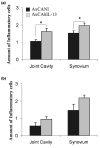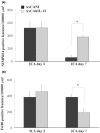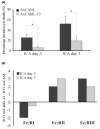Local IL-13 gene transfer prior to immune-complex arthritis inhibits chondrocyte death and matrix-metalloproteinase-mediated cartilage matrix degradation despite enhanced joint inflammation
- PMID: 15743487
- PMCID: PMC1065337
- DOI: 10.1186/ar1502
Local IL-13 gene transfer prior to immune-complex arthritis inhibits chondrocyte death and matrix-metalloproteinase-mediated cartilage matrix degradation despite enhanced joint inflammation
Abstract
During immune-complex-mediated arthritis (ICA), severe cartilage destruction is mediated by Fcgamma receptors (FcgammaRs) (mainly FcgammaRI), cytokines (e.g. IL-1), and enzymes (matrix metalloproteinases (MMPs)). IL-13, a T helper 2 (Th2) cytokine abundantly found in synovial fluid of patients with rheumatoid arthritis, has been shown to reduce joint inflammation and bone destruction during experimental arthritis. However, the effect on severe cartilage destruction has not been studied in detail. We have now investigated the role of IL-13 in chondrocyte death and MMP-mediated cartilage damage during ICA. IL-13 was locally overexpressed in knee joints after injection of an adenovirus encoding IL-13 (AxCAhIL-13), 1 day before the onset of arthritis; injection of AxCANI (an empty adenoviral construct) was used as a control. IL-13 significantly increased the amount of inflammatory cells in the synovial lining and the joint cavity, by 30% to 60% at day 3 after the onset of ICA. Despite the enhanced inflammatory response, chondrocyte death was diminished by two-thirds at days 3 and 7. The mRNA level of FcgammaRI, a receptor shown to be crucial in the induction of chondrocyte death, was significantly down-regulated in synovium. Furthermore, MMP-mediated cartilage damage, measured as neoepitope (VDIPEN) expression using immunolocalization, was halved. In contrast, mRNA levels of MMP-3, -9, -12, and -13 were significantly higher and IL-1 protein, which induces production of latent MMPs, was increased fivefold by IL-13. This study demonstrates that IL-13 overexpression during ICA diminished both chondrocyte death and MMP-mediated VDIPEN expression, even though joint inflammation was enhanced.
Figures





Similar articles
-
Adenoviral vector-mediated overexpression of IL-4 in the knee joint of mice with collagen-induced arthritis prevents cartilage destruction.J Immunol. 1999 Oct 15;163(8):4546-56. J Immunol. 1999. PMID: 10510398
-
FcgammaRI up-regulation induced by local adenoviral-mediated interferon-gamma production aggravates chondrocyte death during immune complex-mediated arthritis.Am J Pathol. 2003 Aug;163(2):743-52. doi: 10.1016/s0002-9440(10)63701-7. Am J Pathol. 2003. PMID: 12875993 Free PMC article.
-
Scavenger receptor class A type I/II determines matrix metalloproteinase-mediated cartilage destruction and chondrocyte death in antigen-induced arthritis.Arthritis Rheum. 2009 Oct;60(10):2954-65. doi: 10.1002/art.24908. Arthritis Rheum. 2009. PMID: 19790077
-
The role of cytokines in osteoarthritis pathophysiology.Biorheology. 2002;39(1-2):237-46. Biorheology. 2002. PMID: 12082286 Review.
-
[Rheumatoid arthritis: new developments in the pathogenesis with special reference to synovial fibroblasts].Z Rheumatol. 2001 Oct;60(5):309-18. doi: 10.1007/s003930170030. Z Rheumatol. 2001. PMID: 11759230 Review. German.
Cited by
-
Interleukin 13 (IL-13)-regulated expression of the chondroprotective metalloproteinase ADAM15 is reduced in aging cartilage.Osteoarthr Cartil Open. 2020 Dec;2(4):100128. doi: 10.1016/j.ocarto.2020.100128. Osteoarthr Cartil Open. 2020. PMID: 33381768 Free PMC article.
-
Functional and Molecular Analysis of Human Osteoarthritic Chondrocytes Treated with Bone Marrow-Derived MSC-EVs.Bioengineering (Basel). 2024 Apr 17;11(4):388. doi: 10.3390/bioengineering11040388. Bioengineering (Basel). 2024. PMID: 38671809 Free PMC article.
-
An Evidence-Based Systematic Review of Human Knee Post-Traumatic Osteoarthritis (PTOA): Timeline of Clinical Presentation and Disease Markers, Comparison of Knee Joint PTOA Models and Early Disease Implications.Int J Mol Sci. 2021 Feb 17;22(4):1996. doi: 10.3390/ijms22041996. Int J Mol Sci. 2021. PMID: 33671471 Free PMC article.
-
Gene therapy for arthritis.Mod Rheumatol. 2008;18(1):2-14. doi: 10.1007/s10165-007-0017-9. Epub 2008 Jan 5. Mod Rheumatol. 2008. PMID: 18176779 Free PMC article. Review.
-
Significance of Interleukin (IL)-4 and IL-13 in Inflammatory Arthritis.Cells. 2021 Nov 3;10(11):3000. doi: 10.3390/cells10113000. Cells. 2021. PMID: 34831223 Free PMC article. Review.
References
-
- Klippel JH, Weyand CM, Wortman RL. Primer on the Rheumatic Diseases. Atlanta: Arthritis Foundation; 1997.
-
- Van Meurs JB, Van Lent PL, Holthuysen AE, Singer II, Bayne EK, Van Den Berg WB. Kinetics of aggrecanase- and metalloproteinase-induced neoepitopes in various stages of cartilage destruction in murine arthritis. Arthritis Rheum. 1999;42:1128–1139. doi: 10.1002/1529-0131(199906)42:6<1128::AID-ANR9>3.0.CO;2-2. - DOI - PubMed
-
- Van Meurs JB, Van Lent PLEM, Stoop R, Holthuysen A, Singer I, Bayne E, Mudgett J, Poole R, Billinghurst C, Van Der Kraan P, et al. Cleavage of aggrecan at the Asn341-Phe342 site coincides with the initiation of collagen damage in murine antigen-induced arthritis: a pivotal role for Stromelysin 1 in matrix metalloproteinase activity. Arthritis Rheum. 1999;42:2074–2084. doi: 10.1002/1529-0131(199910)42:10<2074::AID-ANR7>3.0.CO;2-5. - DOI - PubMed
-
- Nagase H. Activation mechanisms of matrix metalloproteinases. Biol Chem. 1997;378:151–160. - PubMed
Publication types
MeSH terms
Substances
Grants and funding
LinkOut - more resources
Full Text Sources
Medical
Miscellaneous

